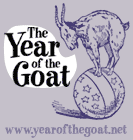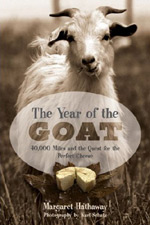Like Jim Schott, LaVerne Charles made an early, web-based impression on our notions of the goat world. Vern, as she prefers, is a seasoned rancher of both goats and cattle, and is moderator of Yahoo's Goats 101 list and several other goat discussion groups that we joined when embarking on this project. As moderator, she keeps everyone polite and on-subject, refraining from censorship, but occasionally sending participants gentle, private reminders of the list's purpose. She also dispenses a lot of advice, and has become a mentor to a number of new farmers across the country, talking them through challenging births, disbudding, and all manner of unfamiliar tasks. At times, people have even called her in the middle of the night with emergency questions; as long as they can give her time to fix a cup of coffee and settle herself at the kitchen table, Vern's happy to help. She holds a wealth of goat knowledge, and her efforts on the internet have truly formed a community for goat farmers (and wannabes, like ourselves) in far flung places. We were thrilled that our schedule in Colorado allowed for a stop in Delta.
On the phone, Vern had invited us to stay the night at Charles Ranch, but warned that she was a "crotchety old lady" who kept an odd schedule because her husband Ken worked nights. We were surprised, then, when we arrived on St. Patrick's Day and were greeted by a trim, friendly woman in overalls and a kelly green tank top, her eyes shaded against the late afternoon sun by a green visor. On a tour of her property, which sits on a plain at the base of the Rockies with a stunning distant view of snow-capped mountains, Vern introduced us to her goats, greeting them by name and treating them to a snack of miniature marshmallows. (Her goats love marshmallows, a quirk she discovered while cleaning the pantry of a stale bag. The one drawback, she discovered, is that if she forgets to take them from her pockets, the drier becomes coated with marshmallow fluff.)
In her lifetime, Vern has raised every major breed of goats except Kiko, though lately she's been concentrating on her lines of Sable Saanens and Boers. Though the animals are pure bred, the pens, which are picturesquely framed in wood and shaded by a giant globe willow, contain a mixture of breeds; goats are segregated by age and gender. Since the animals are domesticated, Vern doesn't see any reason for retaining their horns, which get caught in fences and can injure other goats, not to mention their caretakers. All goats, including the Boers, are disbudded as kids.
In addition to the goats, Vern and Ken raise Scottish fold ear cats, working dogs, and chickens, though recently their bird population was decimated by foxes. Their loss was terrible, but Vern has taken it in stride. A couple of years ago, she said, she made the decision to stop fretting about the small tragedies of the farm, whether they were deaths among her animals or long term projects that just haven?t gotten finished. She tries instead to focus on the simple joys of her animals — the prancing kid who takes a running slide across an overturned washbasin, the pregnant doe who waddles over for a scratch and a marshmallow.
Vern has consciously bred her goats for friendliness, and though most had been dam-raise, her animals were among the most affectionate we've encountered. They are so gentle, in fact, that many of them have gone on to become pack goats in a summer program for at risk children run by a local friend of Vern's. Just spending time with the goats seems to help. As Vern says, "When you're out with the kids, you just can't be sad." —MMH




